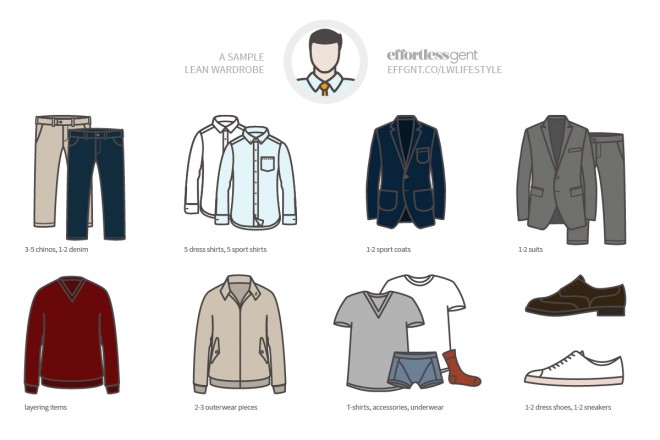“Dressing well” is relative, just like how the idea of “clean, healthy food” is relative.
Mind-blowing, right? Well, not really. Consider these comparisons:
- A 16-year-old junior in high school will have a different definition of dressing well than a 31-year-old working professional
- A 40-year-old banker will dress differently than, say, a 40-year-old cattle raiser
- A company’s mailroom guy has a different uniform than the company’s CEO
- Founders dress differently from company to company
Each of these guys has a different definition of dressing well, and here’s why…
Assess Your Lifestyle
To find the ideal Lean Wardrobe for YOU, you have to consider three things. Here they are (and questions to help you evaluate each one):
1. Your situation
What is your life like on a daily basis?
If you work, do you work from home? Is your job very physically demanding? If you work in an office, do you commute by bike? Do you walk? Drive or take public transit? What is your job’s dress code? Is there one at all? (Switch “job” for “school” if you’re still in school.)
How about after work or class, on evenings and weekends? What do you do during those times you’re not in work clothes?
Do you see a lot of concerts? Go out to fancy dinners? Do you attend plenty of events that require you to wear specific attire?
Do you travel frequently? Are you physically active, always playing sports or exploring in nature?
2. Your income
How much disposable income do you have on a monthly basis (income left over after bills and savings)?
What percentage of that can you devote to improving your wardrobe on a regular basis, be it one item a month, or several pieces every three months?
What stores carry Lean Wardrobe-approved items in your price range? Keep in mind that no matter your budget or income, there are options.
3. Your surroundings
Where in the world are you? Does your corner of the world boast a temperate climate? Do you experience four complete seasons? Are your summers particularly hot, or winters extremely cold?
Do you live in a place that is constantly hot year-round? Is it a dry heat, or is it very humid?
Constantly cold year-round? Extreme weather conditions (wind, snow and ice storms)?
Understanding the particulars about your location’s climate will determine how you build your Lean Wardrobe.
Those you surround yourself with
Besides weather, consider the people you surround yourself with. How do they dress? What’s the “accepted” style among your friends? Really evaluate how they dress and present themselves.
How about your peers? How do people in your general age group dress in your town or city? What about those you work with?
I’m not saying you have to dress like them, or that you can’t dress differently, but understanding how those around you dress will define the different levels of what’s “acceptable” and “practical”.
Here’s an example: If you live in a farming community, where your closest neighbor is a mile / km away and you’re surrounded by your crops, wearing a three-piece suit on a daily basis probably isn’t practical.
You can wear a suit if you want to, but based on your surroundings and situation, it’s not the most sensible choice.
Another example: If you work from home, but you live in Manhattan, it’s perfectly acceptable to wear a suit while at your home office. What if you needed to step out for a meeting, or for a quick lunch? Will you look odd walking around Manhattan in a suit? Not at all.
Sure, you could work in your pajamas, or in jeans and a T-shirt, but based on your surroundings, a suit isn’t out of the question.
How can I apply this?
Ask yourself the above questions. By doing so, you’re evaluating your situation, income, and surroundings. Knowing these answers will help you decide on individual clothing items when crafting your Lean Wardrobe.
A real world example

Let’s say we have a guy named Frank, and he’s realizing he needs to improve the way he presents himself at work and in life.
Here are his answers to the above:
Situation
Frank is Director of Product Management at a medium-sized software firm in San Francisco. He’s 32 years old, leads a team of 15, and reports to the Vice President of the company.
The dress code at the office is business casual. Almost everyone wears jeans and sport
Frank drives to work, and his commute is 30 minutes one way. He travels, on average, once or twice every three months for meetings at the New York office.
He and his wife go out to dinner on the weekends, and they enjoy hiking in Marin when the weather’s expected to be warm. He also enjoys cycling and lifting weights at the gym.
Income
Frank earns $125k a year, and after budgeting, decides he wants to allocate $500 a month for the next five months to improve his wardrobe.
Surroundings
Frank is in the San Francisco Bay Area, so the climate is temperate but can get chilly, foggy, and windy in the evenings, especially during the summer months.
He lives 30 minutes outside the city, where it’s generally more sunny and warm. It doesn’t snow where he lives, nor does it get extremely hot or humid.
As far as the people who surround him at work, most people dress casually or business casual. The people in his town are also very casual, mostly in jeans and tees.
He’s at a director-level position at work, so while he doesn’t have to wear a suit, it wouldn’t be so out of place.
What does Frank’s Lean Wardrobe look like?
Taking all those points into consideration, if Frank is starting from scratch, his Lean Wardrobe would look something like this (click to enlarge):
- 3-5 pairs of chinos, various colors (navy, khaki, olive, etc.)
- 1-2 pairs of denim
- 5 sport
shirts / OCBDs - 5 dress
shirts (at least one white, one light blue) - 1-2 sport coats
- 1-2
suits (navy, medium gray) - layering items (quilted vest, crew or V-neck sweaters)
- 2-3 outerwear pieces (trench, pea coat, M65)
- accessories (ties, pocket squares, socks, etc.)
- 1-2 pairs of leather dress shoes
- 1-2 pairs of sneakers
Frank could start off with just the pants, denim, sport
He might discover he actually does need a suit, so he would purchase that next.
Or maybe he realizes he wants to add more layering pieces (good move, Frank), so he picks up a few sweaters.
When building (or re-building) your wardrobe, it’s good to start off small with only a few things. You can always add more items later. This ensures your closet stays lean.
It’s different for everyone
Of course, Frank’s example is just that, an example. Everybody’s ideal Lean Wardrobe will differ, so direct comparisons won’t always make sense.
It’s best to take a step back, assess your lifestyle, and craft a wardrobe around your observations.
Ask yourself these questions, and that will make the process of identifying the necessary items that much easier.
And you? What questions do you ask to evaluate additions to your Lean Wardrobe?

